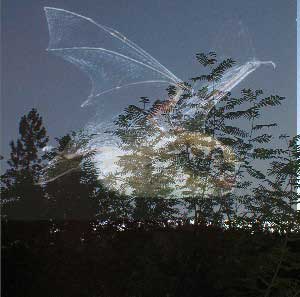 Watch out! |
Bats must be one of the most fascinating and mysterious little critters that I have seen. Some live here in Williams, at least for the summer. We first spotted them one evening in April. I have been watching them every evening since, and listening to them too with my home-built bat detectors. |
What are Bats?
Bats are little mammals that fly. They are the only mammals in the world that can truly fly. They weigh anywhere from a few grams (less than a penny) to several ounces. Their wings are made of a thin skin membrane that is stretched between elongated fingers and their little furry bodies. See the "Bat Parts" picture. Bats are of the order Chiroptera, a Latin word meaning "hand-wing."
Bats, being mammals, breed and have baby bats. The mother bats nurse their babies with bat milk. They usually have a single pup (but sometimes twins) in the spring or early summer. They usually live in colonies as small as a few bats or as large as hundreds of thousands. Bats may live as long as 30 years.
Are they useful, do they eat bugs?
Not only are bats useful, they are very important to us and to the health of our planet. If it were not for bats our world would be full with insects. A little brown bat may eat 1,200 insects in one hour. A colony of 1,000 bats will eat more than a million insects. Many insects are psets to agriculture and can ruin a farmer's crop. Bats feed on pest insects such as beetles, moths, crickets, grasshoppers and mosquitoes.
Some bats feed on the nectar of flowers. In their feeding they pollinate and disperse the seeds of plants. Others are fruit-eating bats and Vampire bats feed on the blood of other animals. Some bats even eat frogs ans fish.
What are the different kinds of bats?
There are almost 1,000 species of bats in the world. Forty-five species live in the United States and Canada. The smallest bat is the Bumblebee bat of Thailand and the largest is the Flying Fox bat of Indonesia. Vampire bats from Central America feed on the blood of other animals and the Fruit-eating bat of Jamaica feeds on green figs.
Some bat speices seen in Southern Oregon are:
Big Brown Bat (Eptesicus fuscus)
Little Brown Bat (Myotis lucifugus)
Pallid Bat (Antrozous pallidus)
Western Small-footed Bat (Myotis ciliolabrum)
Hoary Bat (Lasiurus cinerus)
Yuma Bat (Myotis yumanensis)
California Bat (Myotis californicus)
Western Pipistrelle Bat (Pipistrellus hesperus)
Where and when do we see bats?
Bats hunt insects in wooded areas, open fields and near water. That is where the insects seem to be most plentiful. The bats will appear just after dusk and begin their hunt for insects. They will fly through open areas of the woods, in circles over fields and over the water. They don't like the cold. I have seldom seen bats flying when the temperature is below 60 degrees F., and they don't like it when it rains. They stay at home in their roost.
 Open Field and Sugarloaf Mountain, Williams |
Bats eat insects. During dusk and twilight, they catch the insects in flight, flying intricate patterns of aerobatics. During flight they make sounds with their vocal chords. These sounds are ultrasonic, meaning they are above the hearing range of humans. See: "Listening to Bats." The ultrasonic sounds bounce off insects and the bats hear the reflected chirps and buzz. This is called echolocation. In this way the bats can locate insects, zoom in on them and catch them. |
 Rogue River, North of Williams |
Why are some people afraid of bats? The more we learn about bats, the more we appreciate their qualities and value to our environment. People, historically, have been superstitious about bats. Probably because bats go out at night and we prefer daylight. They are mammals like us but they can fly. Bats are mysterious. The myths: Bats will tangle in your hair and bats will spread rabies are untrue. Bats know very well where they are going and would not wish to have a close encounter with people. Less than 1/10 of 1 % of bats may carry rabies. As with all wild animals there is a possibility of infection if bitten. Bats are not agressive and chose to steer clear of people. |
What can we do to help bats?
Many spesies of bats are endangered due to the loss of their roosting sites in old trees, and caves and by human activity. We can help preserve bat colonies by remembering a few ideas for living with our bat friends.
In winter, avoid places where bats hibernate. If a bat is wakened from hibernation it may starve before spring arrives.
Avoid disturbing caves or places where bats roost. A frightened mother may drop or abandon her baby.
Support efforts to preserve marshes and wetlands.
Consider building or buying a bat house. Bats will often roost in "man-made" structures.
Don't use pesticides near bat roosts or open water.
Support bat conservation/restoration projects.
Next Page - Watching Bats ....
![]()
Home Page .... Bats of Williams .... ![]()
Thanks for your visit. If you have any comments or questions, please e-mail:
lajones@wolfdenpress.net